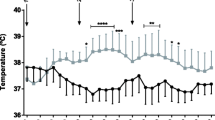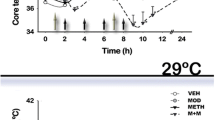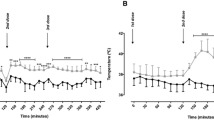Abstract.
The consumption of 3,4-methylenedioxymethamphetamine (MDMA; ecstasy) is known to cause severe hyperthermia and liver damage in humans. The thermogenic response induced by MDMA is complex and partially determined by the prevailing ambient temperature (AT). This is of extreme importance since ecstasy is often consumed at "rave" parties, where dancing takes place in a warm environment, which may exacerbate the effect of MDMA on thermoregulation. In view of the fact that hyperthermia is a well-known pro-oxidant aggressive condition, its potential role in ecstasy-induced hepatocellular toxicity should be further studied. Thus, the present study was performed in order to evaluate the influence of AT on the effects of single administration of MDMA on body temperature and liver toxicity in Charles River mice. Animals were given an acute intraperitoneal dose of MDMA (5, 10 or 20 mg/kg) and placed in AT of 20±2°C or 30±2°C for 24 h. Body temperature was measured during the study using implanted transponders and a temperature probe reading device. Plasma and liver samples were used for biochemical analysis. Liver sections were also taken for histological examination. The parameters evaluated were (1) plasma levels of transaminases and alkaline phosphatase, (2) hepatic glutathione (GSH), (3) hepatic lipid peroxidation, (4) activity of hepatic antioxidant enzymes (catalase, glutathione peroxidase, glutathione reductase, glutathione-S-transferase, copper/zinc superoxide dismutase and manganese superoxide dismutase), and (5) liver histology. The hyperthermic response elicited by MDMA was clearly dose-related and potentiated by high AT. Administration of MDMA produced some evidence of oxidative stress, expressed as GSH depletion at both ATs studied, as well as by lipid peroxidation and decreased catalase activity at high AT. High AT, by itself, decreased glutathione peroxidase activity. Histological examination of the liver revealed abnormalities of a dose- and AT-dependent nature. These changes included vacuolation of the hepatocytes, presence of blood clots and loss of typical hepatic cord organisation. The results obtained in the present study suggest that oxidative stress plays a part in the first stage of MDMA-induced liver damage and that liver antioxidant status is aggravated by increased AT. Thus, these findings are in accordance with the hypothesis that high AT may potentiate ecstasy-induced hepatotoxicity by increasing body hyperthermia.
Similar content being viewed by others
Author information
Authors and Affiliations
Additional information
Electronic Publication
Rights and permissions
About this article
Cite this article
Carvalho, M., Carvalho, F., Remião, F. et al. Effect of 3,4-methylenedioxymethamphetamine ("ecstasy") on body temperature and liver antioxidant status in mice: influence of ambient temperature. Arch Toxicol 76, 166–172 (2002). https://doi.org/10.1007/s00204-002-0324-z
Received:
Accepted:
Issue Date:
DOI: https://doi.org/10.1007/s00204-002-0324-z




